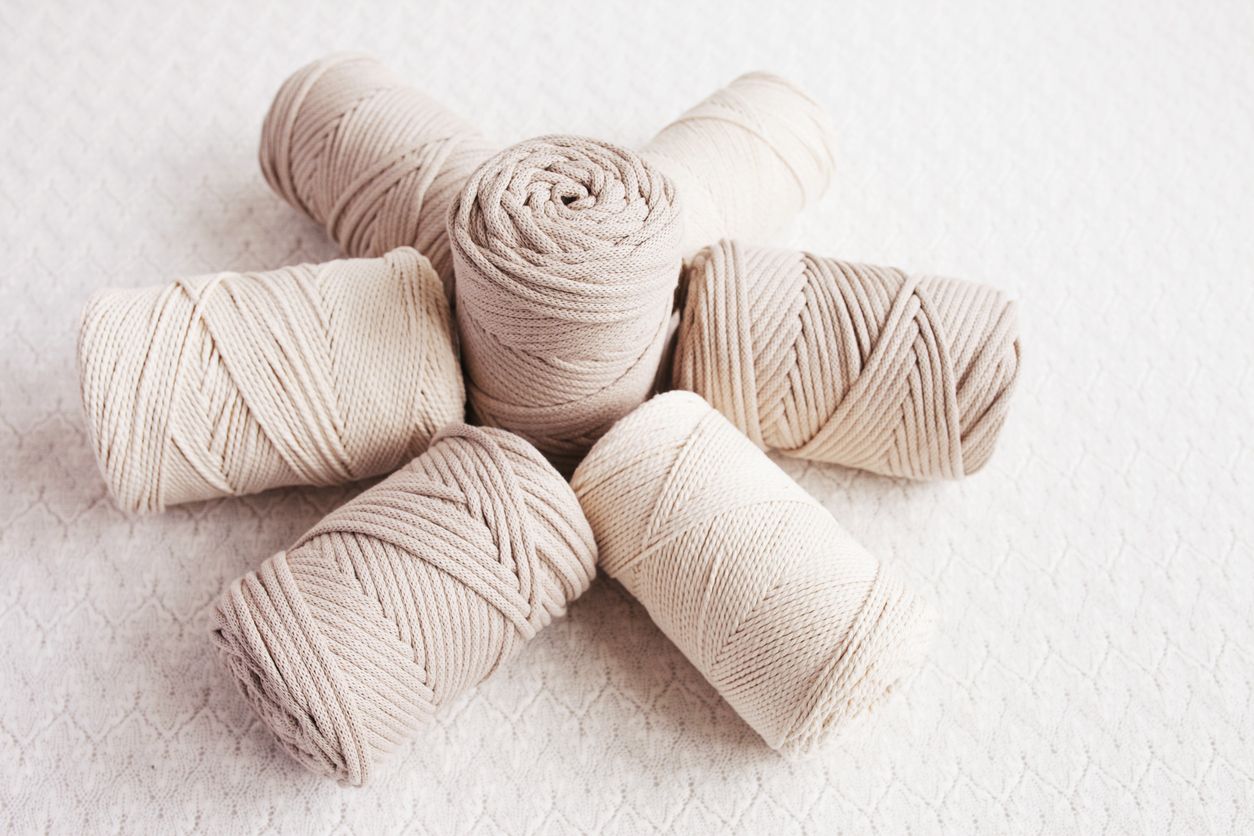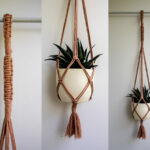Cotton rope comprises fibers from the cotton plant. Cotton plants grow across tropical and subtropical climates worldwide. There are four types of cotton, but Gossypium hirsutum makes up 90% of the world’s total cotton production.
Cotton was one of the first natural materials humans used to create ropes. The use of cotton ropes began in ancient civilizations during the prehistoric era.
The progression of cotton rope-making continued through the middle ages. Gradually, the production made its way to new lands. Our ancestors began creating new tools, like the cotton gin. These tools made cotton production easier and more efficient.
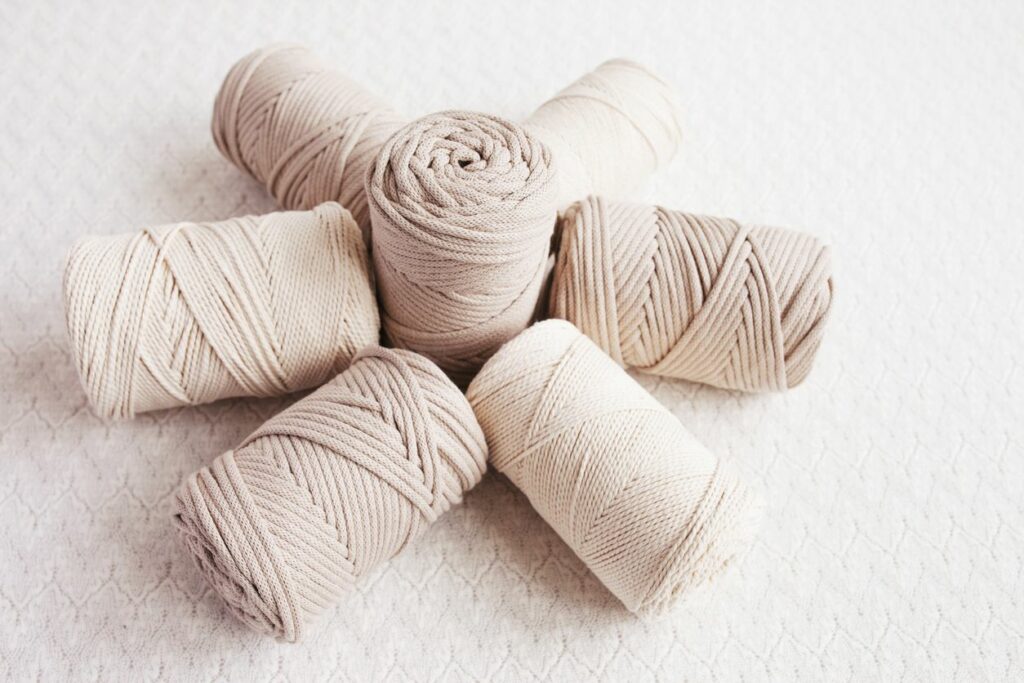
Today, cotton rope continues to be essential to the world. India is the largest producer of cotton in the world.
To make it usable, you must separate the cotton from the seeds, dirt, and other materials. You must fluff the cotton and then spin it into threads. We can then use the threads to create textiles or ropes.
Cotton is the softest kind of rope, so it is weak and not very durable. Cotton rope is soft on the hands and easy to grip. The properties of cotton rope make it a popular material for crafting and home decor.
Six popular uses of cotton rope are:
- Crafts (e.g. macrame)
- Leads for horses
- Pet toys
- Hammocks & chairs
- Magic tricks
- Clotheslines
It’s also important to research other rope materials to see how they compare to cotton rope. Making comparisons ensures you’re choosing the right rope for the job.
What Is Cotton?
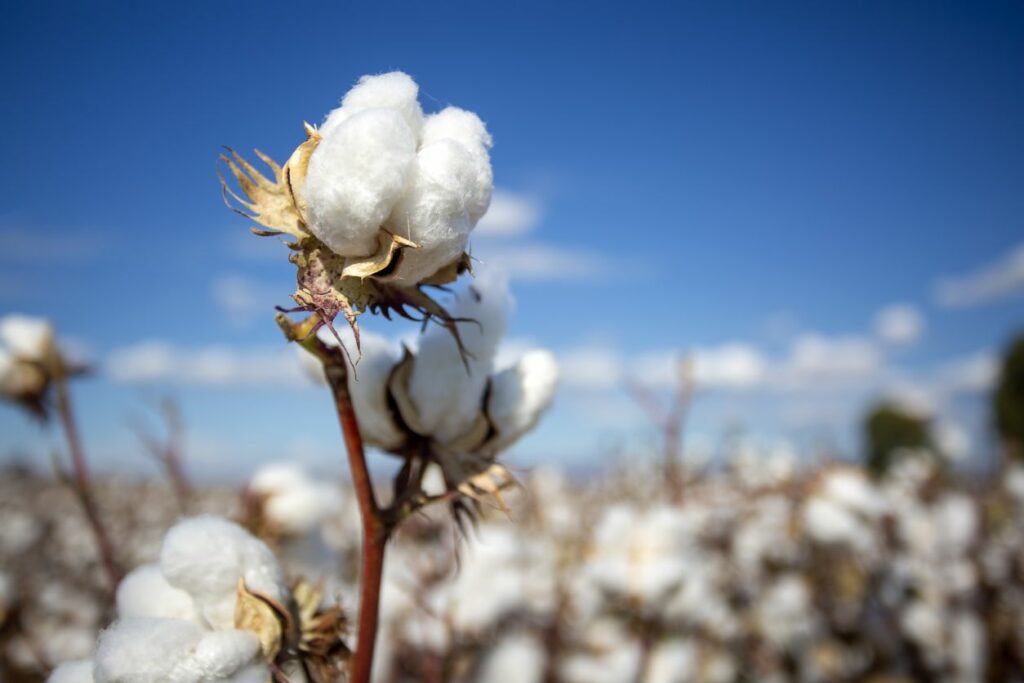
Cotton comes from the cotton plant (Genus Gossypium), which produces soft, fluffy fibers. Cotton fibers grow inside a protective case called a boll that encases the plant’s seeds. Cotton consists almost entirely of cellulose. It also contains small amounts of water, wax, fat, and pectin.
Cotton plants are shrubs that grow in tropical and subtropical regions. The plants need lots of sun and rain and an extended period without frost.
Types Of Cotton
There are four types of commercially-grown cotton:
- Upland Cotton (Gossypium hirsutum)
- Comprises 90% of the world’s cotton production
- Native to Central America, southern Florida, Mexico, and the Caribbean
- Extra Long Staple Cotton (Gossypium barbadense)
- Comprises 8% of the world’s cotton production
- Native to South America
- Tree Cotton (Gossypium arboreum)
- Comprises less than 2% of the world’s cotton production
- Native to India and Pakistan
- Levant Cotton (Gossypium herbaceum)
- Comprises less than 2% of the world’s cotton production
- Native to the Arabian Peninsula and southern Africa
Cotton is further classified into groups that consumers are more likely to recognize:
- Upland Cotton — goes by the same name and is the cotton type most consumers use
- Made from very short fibers
- Pima Cotton — a type of Gossypium barbadense cotton
- Considered by most to be the finest cotton in the world
- Made from extremely soft and extra-long fibers
- Resistant to fading, wrinkling, & tearing
- Egyptian Cotton — a type of Gossypium barbadense cotton
- Grown in the Nile River Valley of Egypt
- Organic Cotton
- Any kind of cotton that is not genetically modified and is grown without chemicals
Where Is Cotton Grown?
Cotton plants are native to tropical and subtropical regions worldwide. Cotton plants grow in the Americas, Africa, India, and Australia ( according to Statista, China was the leader in producing cotton ) Mexico holds the greatest diversity of cotton plants. Australia and Africa closely follow behind them.
Where Did Cotton Originate?
Cotton plants are versatile and grow in a variety of locations around the world. Ancient civilizations have been using cotton for thousands of years.
Ancient Civilizations
The oldest cotton textiles date back to prehistoric times in the fifth millennium BC. Historians discovered pieces of these prehistoric fabrics in the Indus Valley Civilization.
We have evidence from 5500 BC that people in ancient India used cotton. Historians studiend the Neolithic site of Mehrgarh at the bottom of the Bolan Pass. There, they found pieces preserved inside glass beads. Today, this area is part of Balochistan, Pakistan.
Cotton may have existed in Tehuacan, Mexico, as early as 5500 BC as well, but historians are unsure of the exact date.
The domestication of upland cotton existed in Mexico between 3400 and 2300 BC. Evidence shows the daily use of cotton between Rio Santiago and Rio Balsas. They spun, wove, sewed, and dyed cotton. They exported about 116 million pounds of extra cotton to the Aztecs annually.
The cultivation of extra-long staple cotton dates to about 4200 BC in Peru. It was essential to the Norte Chico, Moche, and Nazca civilizations. They wove their cotton into fishing nets. They also traded cotton with other fishing villages along the coast.
The cultivation of cotton also occurred across Arabia, Iran, the Kingdom of Kush, and China.
Giving Cotton A Name
The word “cotton” has Arabic origins, coming from the Arabic word قطن (qutn or qutun). We first saw the word described by Marco Polo when he visited Xinjiang. He described Xinjiang as the province of Khotan in Turkestan. The romance languages added words for cotton around the 12th century. It entered the English language in the 13th century.
The Middle Ages
The eastern world continued to produce cotton into the middle ages. They began ramping up production with the invention of the cotton gin. A cotton gin is a handheld roller that makes cotton production more efficient. The creation of the device occurred in 6th century India and began making its way to other countries. The dual-roller gin came about between the 12th and 14th centuries.
Cotton made its way to Europe as an imported good in the late medieval period. Cotton production began in Europe during the conquest of the Iberian Peninsula. The people of northern Italy learned how to weave cotton in the 12th century. The invention of the spinning wheel around 1350 AD sped up the process. By the 15th century, cotton was exported to Venice, Antwerp, and Haarlem ports.
Early Modern History
Cotton production continued to become more efficient during the early modern era. The Mughal Empire was part of the Indian subcontinent. During the 16th and 18th centuries, they produced more cotton than any other textiles.
The Indians created the worm gear roller cotton gin. Creation occurred between the 13th and 14th centuries. The Mughal Empire began using it in the 16th century. They also began using the spinning wheel. For much of cotton’s history, villagers made cotton in small batches. The Mughal Empire brought cotton into towns for large production. Using all these devices allowed for increased production of cotton textiles. Increased production also lowered the cost.
Around the same time, Egypt began to ramp up its cotton production. By the 19th century, Egypt was the 5th largest cotton producer in the world by production per capita. Later in the 19th century, Muhammed Ali introduced steam engines to the industry. By 1903, Egypt was selling 1.2 million bales of cotton a year.
In Europe, cheap calico and chintz cloth were available. Due to political issues, citizens stopped buying those textiles. Instead, they switched to imported cotton. So, Parliament passed a series of acts, making it illegal to import cotton cloth. Yet, cotton continued to be smuggled into Britain. Due to pressure, Parliament repelled these acts in 1774. The repeal immediately increased the production and demand for cotton.
British colonization allowed the sale of British-produced cotton in India. British-produced goods were not subject to tariffs or duties. Local Indian cotton, on the other hand, was heavily taxed. Such regulations gave Britain a monopoly over India’s cotton resources and market. Britain eventually overtook India as the world’s leading cotton textile manufacturer.
In America, cotton production was a huge source of wealth for southern landowners. Before 1865, enslaved African Americans were the main cotton producers in the south. Slavery ended in 1865, but the cotton industry continued to thrive. Sharecroppers began working in the field instead. Sharecroppers were farmers without land. They worked on another farmer’s land for a share of the profits.
Modern History
In the 20th century, hand-picking cotton died off. Hand-picking was replaced with the invention of machines that did the work.
Today, India is the largest cotton producer in the world. The United States is the largest exporter. Worldwide, we create 110 million bales or 25 million tonnes of cotton annually. Cotton plant farming takes up about 2.5% of the world’s farmable land. Cotton continues to be the most common natural fiber that humans use.
How Is Cotton Made?
Cotton grows naturally within the cotton plant, but we refine it and use it to make textiles. Usually, we spin cotton into thread or yarn that we use to create durable and breathable textiles.
For much of cotton’s history, humans spun yarn and thread by hand. Eventually, we invented the spinning jenny, spinning frame, and spinning mule. These machines sped up the process, making cotton production more efficient.
The machine that really changed the production of cotton was the cotton gin. Cotton gins mechanically separate the cotton from the dirt, seeds, and lint. Cleaning cotton used to take hours by hand. It used to take around 600 hours to craft one bale of cotton, but with the cotton gin, it only takes about 12.
Today, cotton production begins with a cotton picker or stripper. A cotton picker picks the entire plant from the field. A cotton stripper removes the boll from the plant.
Second, the cotton is baled and sent to the gin for cleaning and fluffing.
Thirdly, the raw cotton is compressed for storage and is ready to be shipped to textile mills.
Lastly, the cotton goes through a carding machine. The carding machine further cleans and fluffs the cotton. Then, the machine twists the long fibers into untwisted rope ready for weaving.
Cotton Is The Softest Kind Of Rope
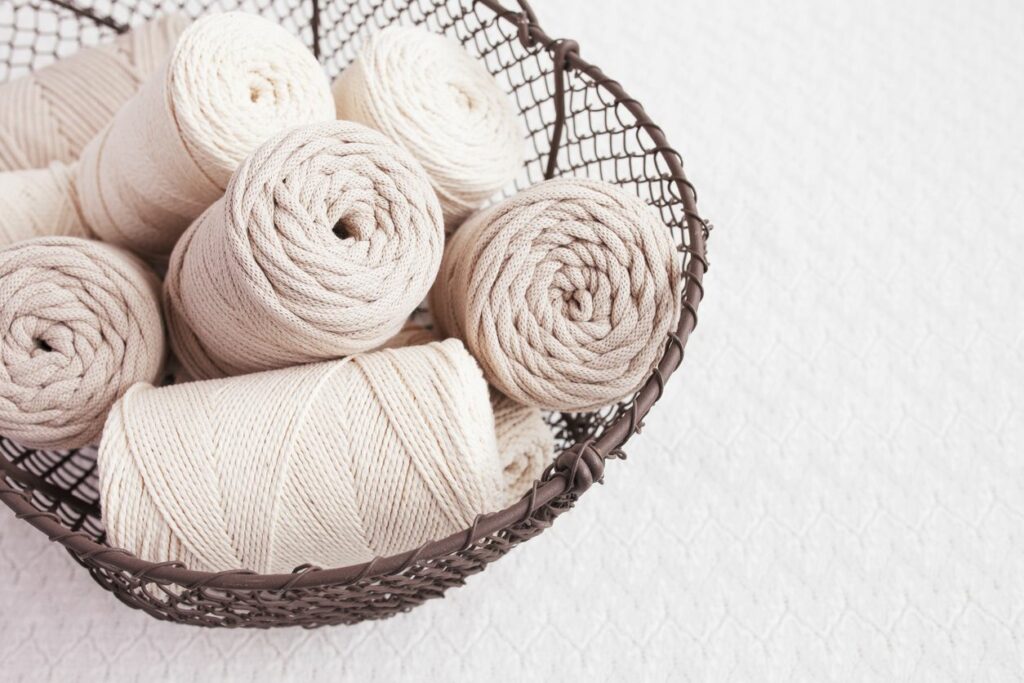
Cotton is the softest rope material making it easy on your hands and good for use around pets. It is one of the least durable kinds of rope. Still, if you only use it indoors where it’s safe from the elements, it lasts a long time. It is absorbent, which makes it unideal for outdoor use, but perfect for dying for crafts.
What Is Cotton Rope Used For?
Cotton rope is excellent for tying knots and indoor activities. Cotton rope is flexible and soft on the hands.
Cotton ropes have 7 common uses:
- Crafts
- Horse leads
- Pet toys
- Dying
- Hammocks and chairs
- Clotheslines
- Magic tricks.
Cotton rope does not trap odors, making it a good choice for household items. It’s hypoallergenic, so it won’t trap allergy-inducing pet particles even when used as a pet toy. The material is also fire retardant, making it safe for use within your home.
Cotton rope isn’t the best option for outdoor use or heavy-duty lifting. It is not strong and is not very resistant to water or rot. Cotton is incredibly absorbent, making it good for dying, but it will rot when introduced to water. Still, cotton ropes dry quickly. So, they are more resistant to rot than other natural rope materials.
Crafts
Soft to the touch, cotton rope is an excellent choice for a variety of crafts:
- Rope baskets
- Storage baskets
- Hanging plant baskets
- Laundry baskets
- Keychains
- Jewelry
- Handbags
- Coasters
- Curtains
- Lamp shades
Macrame is an art form that uses soft cotton ropes to create intricate designs. Macrame is excellent for making simple hanging decorations. You can also create practical items like baskets and plant hangers.
Macrame was popular in the 70s during the hippie era, but 50 years later, macrame is making a big comeback.
Natural cotton rope is white and very absorbent. It is perfect for creating colored cotton rope. To color your rope, all you need is a bit of dye.
Cotton Lead Ropes For Horses
Cotton lead ropes are great for horses because they are flexible and easy to grip. The softness of the rope is less likely to leave you with rope burns and will be gentler on your horse’s skin. The rope is strong and durable enough to hold the horse in normal conditions. It is also soft enough to cut through in emergencies.
Pet Toys
Cotton rope toys are excellent for both cats and dogs because it’s easy on your hands and their teeth. The softness of the rope is gentle on your hands, preventing rope burn. The natural fibers are also gentle on their gums and teeth. It also acts as a natural floss-like material to help clean their mouth.
Cotton rope does not hold odor, so the bacteria in your pet’s mouth won’t make the toy smell. Still, the moisture will cause it to lose durability more quickly. The flexibility of cotton rope makes it an excellent choice for playing tug-of-war.
You will also hear that cotton rope toys are suitable for birds. Many experts recommend against them. Cotton rope fibers can cause impaction if swallowed. Birds may also strangle themselves on it. Rather than cotton, opt for safer rope-like materials like grass and hay.
Hammocks & Chairs
Cotton rope is good for hammocks and hanging rope chairs. It’s flexible and more readily conforms to your body. They are more comfortable than polyester hammocks and chairs. Still, they are less durable for use outside.
Magic Tricks
Cotton rope is good for magicians because it cuts easily while performing a trick. The material is flexible and hangs nicely in your hand as well. The soft material makes the rope easy on your hands and prevents rope burn.
Clotheslines
Clotheslines comprising cotton are superior to plastic clotheslines. Their natural materials make them environmentally friendly. The thickness and flexibility of the rope also mean it will last longer than a plastic one.
How Does Cotton Compare To Other Rope Materials?
Consult the chart below to see how cotton rope compares to other rope materials:
| Fiber Type | Strength | Stretchiness | Durability | |
| Cotton | Natural | Weak | Moderate | Poor |
| Manila | Natural | Moderate | Good | Poor |
| Sisal | Natural | Weak | Good | Good |
| Coir | Natural | Strong | Good | Moderate |
| Hemp | Natural | Strong | Poor | Good |
| Polypropylene | Synthetic | Moderate | Great | Good |
| Polyester | Synthetic | Strong | Great | Great |
| Dyneema | Synthetic | Very Strong | Poor | Great |
| Nylon | Synthetic | Very Strong | Good | Good |
| Polyethylene | Synthetic | Moderate | Moderate | Great |
FAQs
How Much Does Cotton Rope Cost?
The cost of cotton rope depends on the width, length, and amount of rope you buy. It’s generally a cheap material. For instance, at Walmart, you can buy 10 feet of ⅝ inch-diameter cotton rope for only $9.78. Three hundred feet of that same rope would be $293.52.
How Much Weight Can Cotton Rope Handle?
The strength of a cotton rope depends on the rope’s diameter. For instance, a 3/16-inch-diameter rope has a tensile strength of up to 319. A ½-inch-rope has a tensile strength of up to 1500.
Most cotton rope is twisted, but braided cotton rope can hold heavier loads. A braided cotton rope with a 3/16-inch-diameter has a tensile strength of up to 525. A ½-inch-diameter braided rope has a tensile strength of up to 2100.
Tensile strength is the stress a material can handle before breaking or stretching.
Does Cotton Rope Shrink When Wet?
Yes, cotton rope and other natural fiber ropes shrink when wet. Natural fiber ropes absorb water more efficiently than synthetic materials. When they absorb water, the fibers swell, causing the length of the rope to shrink.
